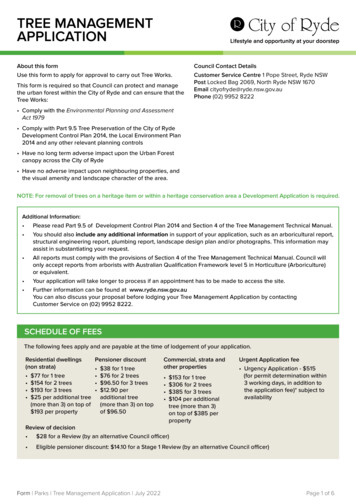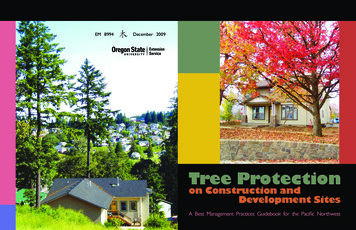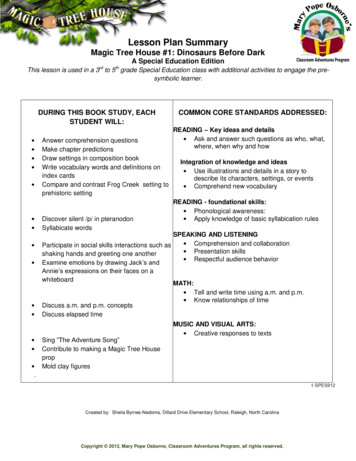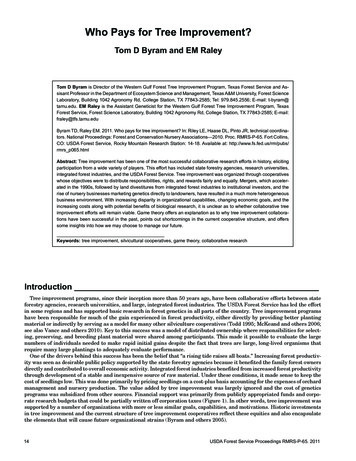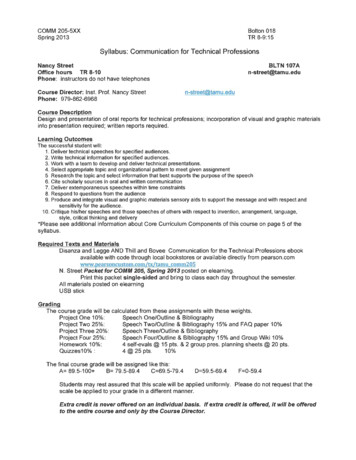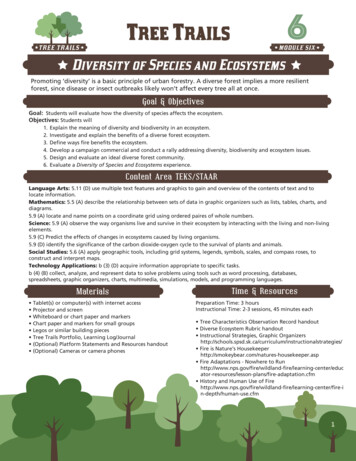
Transcription
TR E E T RA I LSTree Trails6MODUL E SIXDiversity of Species and EcosystemsPromoting ‘diversity’ is a basic principle of urban forestry. A diverse forest implies a more resilientforest, since disease or insect outbreaks likely won’t affect every tree all at once.Goal & ObjectivesGoal: Students will evaluate how the diversity of species affects the ecosystem.Objectives: Students will1.2.3.4.5.6.Explain the meaning of diversity and biodiversity in an ecosystem.Investigate and explain the benefits of a diverse forest ecosystem.Define ways fire benefits the ecosystem.Develop a campaign commercial and conduct a rally addressing diversity, biodiversity and ecosystem issues.Design and evaluate an ideal diverse forest community.Evaluate a Diversity of Species and Ecosystems experience.Content Area TEKS/STAARLanguage Arts: 5.11 (D) use multiple text features and graphics to gain and overview of the contents of text and tolocate information.Mathematics: 5.5 (A) describe the relationship between sets of data in graphic organizers such as lists, tables, charts, anddiagrams.5.9 (A) locate and name points on a coordinate grid using ordered paires of whole numbers.Science: 5.9 (A) observe the way organisms live and survive in their ecosystem by interacting with the living and non-livingelements.5.9 (C) Predict the effects of changes in ecosystems caused by living organisms.5.9 (D) identify the significance of the carbon dioxide-oxygen cycle to the survival of plants and animals.Social Studies: 5.6 (A) apply geographic tools, including grid systems, legends, symbols, scales, and compass roses, toconstruct and interpret maps.Technology Applications: b (3) (D) acquire information appropriate to specific tasks.b (4) (B) collect, analyze, and represent data to solve problems using tools such as word processing, databases,spreadsheets, graphic organizers, charts, multimedia, simulations, models, and programming languages.Materials Tablet(s) or computer(s) with internet access Projector and screen Whiteboard or chart paper and markers Chart paper and markers for small groups Legos or similar building pieces Tree Trails Portfolio, Learning Log/Journal (Optional) Platform Statements and Resources handout (Optional) Cameras or camera phonesTime & ResourcesPreparation Time: 3 hoursInstructional Time: 2-3 sessions, 45 minutes each Tree Characteristics Observation Record handout Diverse Ecosystem Rubric handout Instructional Strategies, Graphic tructionalstrategies/ Fire is Nature’s er.asp Fire Adaptations - Nowhere to tion.cfm History and Human Use of -center/fire-in-depth/human-use.cfm1
Instructional ProceduresI. Engage/ExciteA. Large Group Activity: Ask the students if they have noticed different kinds of trees around theirneighborhood. Take students outside on a walk around the school grounds. Move students intosmall groups consisting of three or four students. Assign all groups a specific area of the schoolgrounds to investigate. But assign only one group to a section that has limited diversity of plantsor trees, such as just grass or just one type of plant or tree.B. Small Group Activity: Ask each group to investigate their assigned section for a variety of plantsand animals and trees. Provide each group paper and with a list of different tree characteristics toobserve: size, shape, leaves, fruit, and bark. Tell students to list the plants and animals theyobserve and to indicate the characteristics of the trees they observe on the tree characteristics list.Ask each group to appoint a recorder to take notes and/or photographs of the trees, animals andorganisms they observe. Students need to save their tree characteristics list, their notes anddrawings and the photographs for the evaluation section.C. Small Group Activity continued: Give each group a set of Legos or building pieces. Have eachgroup build a replica to represent their landscape with different trees, shrubs, plants, etc. Theymay add birds and animals on the trees and ground. The group without contrasting landscape willbuild a landscape also. Ask each group to talk briefly about their landscape. Then have all groupsconnect their landscapes to represent the entire area observed.D. Large Group Discussion: Ask students to notice that one set of building blocks does not have muchdifference, it is mostly the same. Help students connect the concept of “Diversity” to theirlandscape replicas. Ask students why diversity is important. Ask what might happen if we did nothave diversity and all landscapes were the same. Guide students to conclude that without diversity,the landscape would not be as varied and pleasing; animals would not be different and the healthof the trees might be affected. For instance, one disease could wipe out the entire population. Tellthem they will learn more about diversity and its importance in this module.E. (Optional): Large Group Demonstration: Ask students what it would look like if a destructive insector disease invaded the landscape. A student group could pretend to be the pest and swoop acrossthe blocks and knock them down to animate that an insect or disease could seriously harm thediversity of the landscape.F. (Optional) Individual Activity: Have the students take the Diversity of Species and Ecosystemspretest.Teacher Tip: Explain that the test is only to make sure the learning activities are appropriateand not something they already know. The pretest will help them know more about what theywill be learning.To administer the tests by paper, copy from the teacher lesson module. To administer the testelectronically, recreate the test in an online survey program. Free programs allow the creatorto see results from a class set.II. ExploreA. Large Group Discussion: Lead a brief discussion to explain that the purpose of this module is to2Module 6
II. Explore continuedunderstand how the diversity of trees, the biodiversity of forestsand animals and its ecosystems are important to our communityDiversityEcosystemand world. Depending on the depth of student knowledgeabout these terms, a Venn diagram concept map may be used toexpand the students prior knowledge. The diagram should havethe terms “Diversity” and “Biodiversity” in two ovals that areBiodiversityconnected and these two terms connected to an oval with“Ecosystem” on a chart/whiteboard. (Optional: Combine Diversityand Biodiversity into the same oval to make two ovals instead of three.)B. (Optional) Small Group Discussions: Move students into small groups to explore the threeconcepts: Diversity, Biodiversity and Ecosystem. Ask students to discuss and define the differencebetween diversity and biodiversity and ecosystems and the relationship between the concepts.C. Large Group Discussion: Write or have students write their responses around or on thecorresponding area of the diagram. Have students draw a conclusion that describes therelationship of these concepts and write that description at the bottom of the chart.Teacher Tip: As students respond with their definitions, lead a discussion to help themunderstand the difference in the terms: diversity, biodiversity and ecosystems. Diversity is thedifference in a set of like species, such as trees. Biodiversity means the diversity, or variety, ofplants, trees, animals and other living things in a particular area or region. An ecosystem is acomplex set of relationships among the living and non-living resources, habitats, and thecommunity of residents of the area. This includes plants, trees, animals, birds, fish,microorganisms, water, soil and people interacting as a system. Everything that lives in anecosystem is dependent on the other species and elements. The balance of an ecosystem isdelicate and a disruption, such as the introduction of a new element, can damage or interruptthe balance.III. ExplainA. Large Group Discussion: Have a discussion about elections and campaigns. Ask students to define acampaign and tell what makes a campaign successful. Lead students to conclude that a campaignmust provide convincing reasons to vote for the candidate. Tell students to imagine that they havejoined a campaign to elect Mr. D. V. Forest as Mayor. The campaign’s purpose is to convince thepublic that Mr. D. V. Forest is the best candidate for Mayor. He has promised to address the public’sbiggest concerns about diversity, biodiversity and the forest ecosystem.B. Large Group Discussion continued: Explain to the students the steps they will take to create aCommercial and have a Campaign Rally to get Mr. D. V. Forest elected. The students will need todivide into small Campaign Committees to address different platform statements. Students should1. research one campaign platform statement, 2. write a convincing script for their platformstatement, 3. make the script into one section of the commercial, 4. put all the sections together tocreate the Campaign Commercial and 5. conduct a Campaign Rally using their section of thecommercial.C. Large Group Discussion and Small Group Assignments: Put the following platform statements on a3Module 6
III. Explain continuedchart/whiteboard or pass out the Diversity Platform Statements and Resources handout so allstudents can read and make a selection. Ask students to select one platform statement they wantto research. As possible, assign the students to the platform committee of their choice. Eachcommittee should appoint a leader, recorder, reporter and assistants to find the answers. Theplatform statements and the supporting resources are:1. Platform: Every forest needs to contain a variety of habitats that support diverse,interdependent communities of plants and animals.Resources: Have students return to the list of diverse trees, plants and animals they observedearlier. Have them focus on the interaction of the ecosystem organisms. (They may need toreturn outside to add to their lists. They may make a food chain and/or take pictures orvideos to use in the commercial.)2. Platform: We need to promote a diverse forest because of its many benefits.Resources: Make pictures or videos of the forest benefits we share in our ecosystem.3. Platform: We need to evaluate how altering a forest environment affects all living things andinterrelationships in an ecosystem.Resources: Use pictures or make a before and after drawing depicting a change in thediversity of their own environment and the way it would alter the landscape.4. Platform: We need to better understand fire and ways to use fire to benefit natural habitatsand the ecosystem.Resources: Fire is Nature’s Housekeeper. Review the website and animated illustrations.Have students summarize the presentation and/or show it or parts of the recording.5. Platform: We need to understand how animals and plants, including trees, protectthemselves from fire so we can promote a better ecosystem for them.Resources: Nowhere to Run section of the National Park Service’s Fire Adaptations lessonbackground information on helping animals and plants and trees protect themselves. Reviewthe website.Have students summarize the internet information and/or show parts to the class.6. Extra Platform, Potential Teacher Committee: Remind the public of how Native Americansmanaged forests with fire and the History and Human Uses of FireResources: National Park Service’s Human Use of Fire information on how Native Americansmanaged forests with fire. Review the website.Have students summarize and/or show sections of the internet resource.IV. Extend/ElaborateA. Small Group Activity: Provide students with a format to compile the research and develop a scriptfor the campaign commercial. They should develop a platform statement presentation that willnot take more than two to four minutes to present.1. Topic: the Platform Statement4Module 6
IV. Extend/Elaborate continued2. Purpose: one sentence telling why this action is important3. Findings: three to five phrases or sentences telling how to make this action happen4. Conclusion: summary of what Mr. D. V. Forest will do (one sentence)B. Small Group Activities continued: Once the groups have finished their research and script, havethem add music and/or interesting media into their commercial section.C. Large Group Presentation: Brainstorm possible slogans for the campaign. Have students vote ontheir choice. Each of the small groups come together to conduct the recording/filming of thecommercial. Select someone (teacher, administrator, student or parent) to introduce the candidatefor Mayor (selected by the class) and the campaign committees. Each group presents theirplatform script. Then, for the ending, all groups may chime in to convince the public to elect Mr.D. V. Forest who will “Make the Forest Ecosystem Better for All” or (whatever slogan is chosen).D. Large Group Activity: Take the groups outside to conduct the rally to take advantage of thesetting to present the mayor and the platform committee’s stand on issues related to diversity,biodiversity and the ecosystem. Invite other classes to attend. The person selected to introducemay also close the rally by restating all the reasons the public should elect Mr. D. V. Forest forMayor. Other students, parents, etc. may record and/or take pictures to display after the campaignrally.V. EvaluateA. Small Group Activity: Have each group retrieve their photographs, drawings, notes, etc. fromExcite: B. Have students review their work and decide what needs to be added to make a better,more diverse landscape to their materials. Provide each group with the diverse ecosystem rubric toassist them with adding the ingredients that can create a better landscape. Have each group sharewith another. hen have the class decide which group has developed the most diverse ecosystem.B. (Optional) Individual Activity: Have students take the Diversity of Species and Ecosystems posttest.Have them compare their results to self-evaluate what they learned and what they did not know.Teacher Tip: You may use the results to determine the need for Extra Mileage/Attention.VI. Extra Mileage/AttentionExtra Mileage: Have students locate a different forest ecosystem (in another area of the community, alocal park, the state capitol or county seat, etc.) and evaluate it according to the Diverse EcosystemRubric handout.Extra Attention: Have an “expert” peer work with students to draw a community that has diversity,biodiversity and is a healthy ecosystem.Tree Trails curriculum was developed by Texas A&M Forest Service in cooperation withTexas Urban Forestry Council and was supported by a grant from the USDA Forest Service.5Module 6
Student Assessment / Pretest and PosttestDiversity of Species and EcosystemsDirections: Answer the following questions by rating your response 1-5, with 5 being thehighest.Key:1.1 Not Sure2 Poor3 OK4 Good5 GreatI can define the difference in diversity andbiodiversity.123452.I can describe an ecosystem.123453.I can tell why a forest ecosystem needsdiversity.123454.I can name two ways fire benefits the ecosystem. 123455.I know two causes of an unhealthy ecosystem.123456.I can describe what Native Americans did topreserve their forests.123457.I can evaluate a forest ecosystem community.123458.I can help my family learn more about theneeds for a healthy ecosystem.12345I am interested in knowing what I can do toimprove the quality of the ecosystem in myneighborhood.123459.Comments:
Diverse Ecosystem RubricDirections:Review the ecosystem plan and decide which level your plan achieves. Circle thedescription that fits best for each Quality. Record the points for each below the table andadd them together.1 Point2 Points3 Points4 PointsTree QualitiesLittle or no treesFew of same treesDiverse numberof treesDiversity of treesplanted in ideallocationsPlant QualitiesLittle or noplantsFew of sameplantsDiverse numberof plantsDiversity ofplants planted inideal locationsAnimal QualitiesLittle or noanimalsFew of sameanimalsDiverse numberof animalsDiversity ofuseful animalson landscapeInsect QualitiesLittle or noinsectsFew of sameinsectsDiverse numberof insectsHelpful insectsfound inlandscapeTree QualitiesPlant QualitiesAnimal QualitiesInsect QualitiesTotalScore Review:0-3 Poor Plan, You need more variety, consider adding items for each Quality.4-8 Average Plan, You’re on your way, consider adding items for each Quality.9-13 Good Plan, Well done, your plan shows some diversity.14-16 Excellent Plan, Diversity in your ecosystem shows a healthy system.Module 6TREE T RAI L S
Diversity Platform Statements and Resources1. Platform: Every forest needs to contain a variety of habitats that support diverse, interdependentcommunities of plants and animals.Resources: Return to the list of diverse trees, plants and animals you observed earlier. Focus on theinteraction of the ecosystem organisms. (You may need to return outside to add to your lists. You maywant to make a food chain and/or take pictures or videos to use in the commercial.)2. Platform: We need to promote a diverse forest because of its many benefits.Resources: Make pictures or videos of the forest benefits we share in our ecosystem.3. Platform: We need to evaluate how altering a forest environment affects all living things andinterrelationships in an ecosystem.Resources: Use pictures or make a before and after drawing depicting a change in the diversity of yourown environment and the way it would alter the landscape.4. Platform: We need to better understand fire and ways to use fire to benefit natural habitats and theecosystem.Resources: Fire is Nature’s Housekeeper. Review the website and animated illustrations marize the presentation and/or show it or parts of the recording.5. Platform: We need to understand how animals and plants, including trees, protect themselves from fireso we can promote a better ecosystem for them.Resources: Nowhere to Run section of the National Park Service’s Fire Adaptations lesson backgroundinformation on helping animals and plants and trees protect themselves. Review the website ion.cfmSummarize the internet information and/or show parts to the class.6. Extra Platform: Remind the public of how Native Americans managed forests with fire and the Historyand Human Uses of FireResources: National Park Service’s Human Use of Fire information on how Native Americans managedforests with fire. Review the website enter/fire-in-depth/human-use.cfmSummarize and/or show sections of the internet resource.Module 6TREE T RAI L S
Tree Characteristics Observation RecordDescribe and/or draw the Tree Characteristics observed:Size - compare to the height of anotherobject like a light pole or buildingBranches - how are they organized,what patterns can you seeShape - pretend to draw an outlinearound the tree, describe that shapeFruit - look at color, shape, and sizeLeaves - look at color, shape,size, and movementBark - what patterns are found in thebark, look at color, how does it feelPlants and animals observed:Module 6Sketches of trees, plants, and animals:TREE T RAI L S
Tree Trails curriculum was developed by Texas A&M Forest Service in cooperation with Texas Urban Forestry Council and was supported by a grant from the USDA Forest Service. A. Small Group Activity: Have each group retrieve their photographs, drawings, notes, etc. from VI. Extra Mileage/Attention
